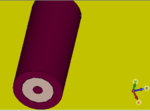kladenstein
Newbie level 5
Hello,
i'm designing a double-ridged horn antenna in CST. First, i designed it with an ideal waveguide port(i chose back surface of the waveguide and add waveguide port) and i took very good s11 and farfield radiation results in my working band(<-20 dB from 1 to 18 GHz and good directivity in the direction of radiation).
But when i feed the antenna with a coaxial probe from bottom of the waveguide, my whole s11 results are corrupted. They are below -10 dB in lots of band i simulate and in radiation patterns main lobs are divided and there are so much side lobs.
I checked some journals and youtube videos and i saw when people add coaxial probe to a horn antenna their s-parameters also corrupted.
- So, I want to ask that these corruptions are normal? if they are not can you advice me what can i do to fix these ? I changed the position of probe. that's not affect so much.
- Also I want to ask which one gives me the more realistic results for horn antenna - ideal waveguide port or coaxial probe. It seems I'll produce this antenna with coaxial probe.
Thank you.
i'm designing a double-ridged horn antenna in CST. First, i designed it with an ideal waveguide port(i chose back surface of the waveguide and add waveguide port) and i took very good s11 and farfield radiation results in my working band(<-20 dB from 1 to 18 GHz and good directivity in the direction of radiation).
But when i feed the antenna with a coaxial probe from bottom of the waveguide, my whole s11 results are corrupted. They are below -10 dB in lots of band i simulate and in radiation patterns main lobs are divided and there are so much side lobs.
I checked some journals and youtube videos and i saw when people add coaxial probe to a horn antenna their s-parameters also corrupted.
- So, I want to ask that these corruptions are normal? if they are not can you advice me what can i do to fix these ? I changed the position of probe. that's not affect so much.
- Also I want to ask which one gives me the more realistic results for horn antenna - ideal waveguide port or coaxial probe. It seems I'll produce this antenna with coaxial probe.
Thank you.











